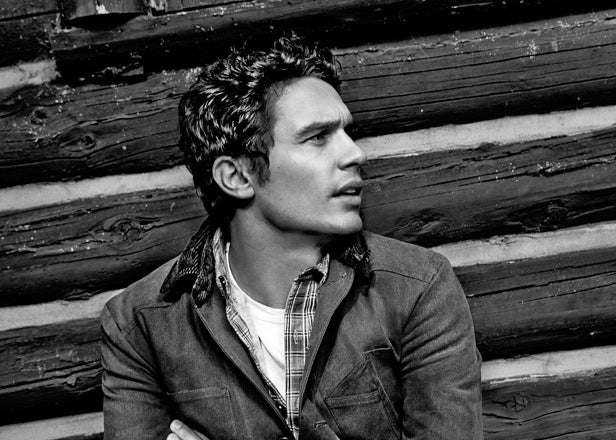Watch a behind-the-scenes video of 127 Hours.
James Franco is in virtually every scene of 127 Hours, delivering a performance that carries an inherently challenging film. Though the story of Aron Ralston’s ordeal in Utah’s Blue John Canyon is dramatic by definition, it’s also fairly static: once the Ralston character gets pinned by the infamous fallen boulder, he stays pinned鈥攄espite attempts to escape by chipping away at the rock and fashioning a pulley system with his canyoneering gear鈥攗ntil the climax sequence, late in the movie, when he cuts his way to freedom.
How do you make a story of claustrophobia and torment not just watchable but entertaining? Director Danny Boyle鈥攚ho laughingly admitted after the movie’s September premiere in Telluride, Colorado, that he “hates” wilderness鈥攄id it by infusing Ralston’s ordeal with a rush of urban energy, accomplished through quick cuts, a hip soundtrack, wiggy flashbacks, and an unleashed Franco, who comes off like a mix of Ralston, Neal Cassady, and MacGyver. That the 32-year-old actor pulled it off won’t surprise longtime fans of his eclectic career, which has taken him from a cult TV show (Freaks and Geeks) through roles in big-payday franchises like Spider-Man to recent indie efforts like his dead-on portrayal of Beat poet Allen Ginsberg in 2010’s Howl. And he’s doing it all while going back to school, taking graduate-level courses in art, literature, and creative writing at Columbia, NYU, and Yale. Editorial director ALEX HEARD caught up with Franco in Telluride between takes and term papers to ask about his approach.
OUTSIDE: Early on in 127 Hours, right after Aron’s right arm is pinned, there’s a great scene in which you throw everything you have into making the boulder move. You’re inside a studio-replica canyon, but the prop rock has real heft and is bolted into place, so fighting it had to hurt. How was that set up?
FRANCO: Danny said, “I’m just gonna roll the camera. Keep going, and don’t stop, and try to get out of it. You won’t get out, but keep trying.” I knew I was going to get beat up, and I said, “OK, I’m happy to do it, but make sure you get it on camera so I don’t have to do it again.” That established a way of dealing with a lot of those scenes, and it ended up being a 20-minute take.
Did you get beat up?
Oh, yeah. After that scene, I was purple all over. But when you keep it going that long, you get pulled into a scene in a much different way, in which you’re really just doing something to try and accomplish it. If you can’t do it after ten minutes, you get really frustrated, especially when it’s something that’s physically draining.
In this role, you had to convey levels of pain and terror that few people can even imagine. What did Aron tell you about his actions down there and about the things he went through?
Early on, we all met with Aron in L.A.鈥擠anny, me, screenwriter Simon Beaufoy, and producer Christian Colson鈥攁nd he showed us the videos he made of himself during his time in the canyon. Then we had him go through 别惫别谤测鈥攅惫别谤测鈥攑art of his journey, had him act it out, for the technical things. We also went out to Utah for two or three days before filming, where he went through everything again with the actual props we were going to use.
You guys seemed especially interested in the videos, in which Aron described to friends and relatives鈥攁nd whoever else might see them鈥攈is predicament and his looming death by dehydration.
Aron doesn’t show those videos to a lot of people. He did show them to us, and they were incredibly powerful to see. They’re of a guy who’s not a performer, talking into a camera to friends, who is coming around to accepting his own death. This was somebody who was trying not to break down in front of his family, just for their sake. So they were monologues with a double layer. No extraordinary Shakespearean soliloquies. Just a plain person, and you’re watching it and you realize, Wow, this guy really believes he’s going to die.
How did he describe the physical pain?
The pain? He said that when the boulder first landed on his hand, the pain was ten or a hundred times worse than anything he’d ever experienced before. But the amputation was like a thousand times more painful. He said it felt like his arm had been thrust into lava, that it was incinerated.
And you had to portray that convincingly, while sawing away with a knife on a prosthetic arm.
Yeah, they had made up a fake arm for me that, inside, was incredibly detailed with muscles, veins, and nerves. But the way Danny handled the amputation sequences was helpful: you get a sense of what’s going on, but in a lot of shots you kind of see it out of focus. With that, the imagination can take over.
Aron has written about having visions during his entrapment: of him going through a cosmic birth canal, of a son he’ll have someday. Those were either the product of a stressed-out mind or genuine spiritual epiphanies. Which do you think?
It’s hard to say. Jesus went out to the desert for 40 days, living in isolation, so there must be something to being in that kind of situation that either changes the brain or opens you up to spiritual experiences. To me, the film is about the stripping away of a human, and it’s a human coming face to face with self, with his mortality, with his beliefs, and with the ways he’s lived his life. When we do basic things like meditation, it’s kind of a stripping away in your head of everything that makes up the personality. So I guess a vision of a child, or whatever else, could be the outcome of such an experience.
Reading the biographical parts of Aron’s book, it’s clear he was an extreme outdoor athlete who almost got himself killed several times鈥攂y avalanche, climbing falls, or drowning鈥攍ong before he got trapped in the canyon. Those parts of his story are absent from the film, and you’ve made the character’s personality a bit edgier than the real-life Aron, who is a fairly easygoing and earnest person. Why?
I’ve played characters who are based on real people before鈥擩ames Dean, Allen Ginsberg鈥攁nd the degree to which I try to take on the mannerisms of the person depends on who the character is. So with the Ginsberg role, one of the points was to give the spirit of, you know, Ginsberg. In 127 Hours, Danny was fascinated with the situation in this story鈥攖he idea of a person being trapped out there. We thought the best way for the audience to access this experience was to have the most bare performance, depicting a guy going through all these trials. We worked with Aron a ton during pre-production, and I know Danny worked with him a ton on the script. But after a while we saw it as Aron loaning us his story, which we had our own experience with, and then us giving it back to him.


